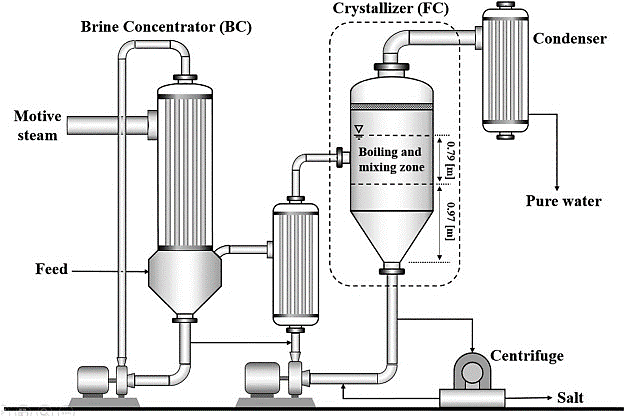
Crystallization is a physical change. Crystallization is the formation of solids from the liquid or gaseous phase. This technique includes obtaining the crystals of a soluble substance from a hot saturated solution and separating the soluble solid from the solution.
To concentrate feed into solid crystals and clean water, crystallizers are used. A progressively harder method for which crystallite sizes are formed from a liquid solution is known as crystallization. Crystallizers can remove liquid wastes completely, resulting in no liquid discharge (ZLD). The process continues and secondary crystallization are the two stages of crystallization. The formation of new crystals is referred to as primary nucleation. Secondary nucleation is the primary stage that results in the mass production of crystals. There are two types of crystallization processes: evaporative crystallization and cooling crystallization.
These common procedures are already proved to obtain detrimental effects on aquatic ecosystems and land vegetation systems11–fourteen. As a result, with ever tightening environmental polices and expanding community environmental awareness, these immediate or semi-direct disposal with the waste brines is going through powerful criticism. As an formidable concentrate on for brine cure, the idea of zero liquid discharge (ZLD) has been given renewed attentions not long ago, because it aims to get rid of all squander liquid and deliver sound salts as the only byproduct7,11,15.
In the meantime, to guarantee continued help, we have been displaying the location with no kinds and JavaScript.
The dense salt crust area layer combined with the salt crystals filling Within the QGF membrane in the situation from the concentrated SWRO brine brings about the failure with the 3D crystallizer in the course of the long run operations.
To understand the drinking water transportation along with the ion focus distribution over the operation in the crystallizer, the salt ion distribution within the crystallizer was simulated. The profile construction on the crystallizers was simulated making use of COMSOL Multiphysics software program. The results with the h2o transport simulation are revealed in Figure 8a. It is obvious which the brine was swiftly transported from the drinking water transportation layer to the photothermal layer. Through brine transportation, brine backflow and also diffusion happened simultaneously. Since the inclusion angle concerning the photothermal layers grew to become more substantial, the diffusion effect of brine became more powerful for the intersection of the photothermal layer along with the drinking water transportation layer.
In addition, as a consequence of its straightforward set up, the array is often put on the rooftop of manufacturing unit buildings, which might further minimize its land footprint. The specific conversations over the scalability of your photo voltaic crystallizer are available in Supplementary Observe S5. With ongoing do the job further more improving upon the efficiency in the solar crystallizer, it is expected that the next-technology solar crystallizer will widen its application standpoint.
A lab-scale set up was crafted to evaluate the solar evaporation and crystallization effectiveness of the photo voltaic crystallizer. A photo voltaic simulator (Oriel solar simulator) was employed to offer solar radiation with a relentless depth of a thousand W m−2. A mass stability (ME204E, Mettler Toledo) was used to report the h2o mass improve. The temperature distribution was monitored by an IR digicam (A600-series, FLIR). The evaporation rates from the photo voltaic crystallizer with different heights when treating pure water have been measured underneath a person Solar illumination for 3 h.
Some modern interface evaporators have already been meant to reach successful water evaporation though also enabling stable salt assortment. These Thoughts also realized ZLD targets of pollution-no cost, zero Electricity consumption for prime-salinity brine remedy.
Fig. four: Photo voltaic evaporation and crystallization habits of serious seawater brine inside the existence of NTA.
The economical utilization of solar energy is usually attributed to which the wall in the cup structure can successfully Recuperate the Electrical power decline from the bottom gentle absorbing surface as reviewed in literature41. The higher clear effectiveness can be discussed by that the unit can obtain additional heat with the environment, simply because nearly all the photo voltaic crystallizer is cooler than its environment even under sunlight (Fig. 2d)30,42–forty four. These results exhibit this 3D solar crystallizer generates a point out-of-the-artwork efficiency in solar-pushed h2o Crystallizer Manufacturer Crystallizer For Zero Liquid Discharge System evaporation.
In this sort, the crystals are formed from the solution when it reacts. This crystallization process is faster than other kinds of crystallization as the response procedure is rapid. The fast conversion section signifies the shortest residence time in all precipitation processes.
Immediately after cooling and salt extraction, the residual brine liquor has a reduced dissolved salt written content (~10%) and will be warmed up and recycled Yet again in the UHP-RO system. A warmth pump is utilized to at the same time great just one part of the circuit even though heating another — presenting significant Electricity efficiency financial savings.
In this perform, a seawater evaporation crystallizer with selected geometry and an interior channel was made as a result of 3D printing. This crystallizer was able of producing salt crystals during the remedy of substantial-salinity brine. The buoyancy layer in the look not only provided buoyancy but will also acted as salt collector and will decrease the overall warmth loss of the crystallizer. By experiment and simulation analyses, it was firm the salt crystallizer having an angle of ninety° involving the photothermal layers could keep ongoing salt crystallization and a greater efficiency of salt harvesting in the substantial-salinity brine ecosystem.
Good disposal of industrial brine continues to be a crucial environmental challenge. Listed here, the authors devise a solar crystallizer and propose a salt crystallization inhibition approach, which alongside one another provide a reduced-Expense and sustainable Resolution for industrial brine disposal with zero liquid discharge.
They can be engineered to face up to corrosion, lessen website installation prices, and improve uptime via strong design and style and smart automation.